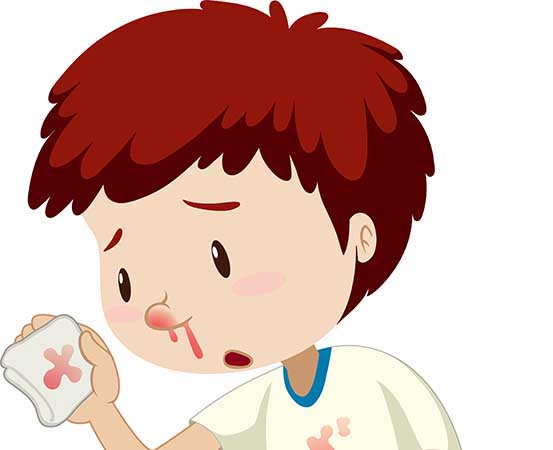
One common mistake people make when a child gets a nosebleed is asking them to lean back to stop the bleeding.
Monica Karthik, a homemaker and a resident of Mysuru, Karnataka, recalls making the same error for almost a year with her five-year-old son until her pediatrician corrected her.
“The first time I saw my son’s nosebleed, I was terrified,” she says. “I pinched his nose and made him lean backwards to stop the bleeding, but it took a lot of time to stop.”
Nosebleed, or epistaxis, is a condition in which bleeding happens suddenly and spontaneously from the front part of the nose. It can happen on one side or even both.
How to stop a nosebleed?
According to Dr Elizabeth Clayborne, CEO and founder of NasaClip, emergency physician and a faculty member at the University of Maryland School of Medicine, Baltimore, parents and caregivers often end up following a wrong technique. “They are often unsuccessful in controlling a nosebleed for their child because they are pinching the wrong part of the nose, tilting the head back instead of forward, or unable to hold constant pressure for the right amount of time,” she says.
Agreeing with her, Dr Supraja Chandrasekar, consultant pediatric intensivist, Manipal Hospitals, Bengaluru, says that when the wrong technique is used by lifting the chin up, the blood enters the back of the nose, then goes into the throat and can potentially cause choking.
According to Dr Clayborne, if a child is bleeding at home, the first step is to have them clear the nose of clots by blowing out any clotted blood. “Parents can use nose-congestion spray, which is recommended by doctors only [for] children above six years of age,” she says. “Hold constant pressure on the nose for a minimum of 10 minutes. Parents should pinch fingers over the soft sidewall of their child’s nose just below where they feel the nasal bone. The pressure needs to be firm — which can be challenging for someone to do on a child but, when done correctly, the nosebleed will stop.”
Dr Neeraj Narayan Mathur, head, department of ENT, Amrita Hospital, Faridabad, Haryana, says that if the bleeding doesn’t stop, parents can use an ice pack or put an ice cube in a handkerchief and put it over the bridge of the nose. He says if these steps don’t help, then it is necessary to take the child to the hospital.
Nosebleeds are not serious
Nosebleeds may be alarming, but typically they are not serious, says Dr Clayborne.
“About 60 per cent of people will get at least one nosebleed in their lifetime,” she says. “Children aged two to 10 and adults aged 55 to 80 are the most vulnerable. [Nosebleeds] are also very common in people with blood disorders, high blood pressure or those who take blood thinners.”
Types of nosebleeds
Dr Clayborne, who is also a member of the American College of Emergency Physicians, says there are two types of nosebleeds:
- Most of the nosebleeds are anterior. In this, the mucosa, the thin membrane that lines the inside of nasal passage, erodes and the vessels become exposed. They then break, causing bleeding in the front part of the nose.
- Posterior nosebleeds are emergencies that present with pumping and profuse arterial bleeding, which comes from further back in the nose.
Why do nosebleeds occur?
Nosebleeds mainly occur in schoolgoing children and in seasons with less humidity, such as very cold winters or very hot summers, says Dr Mathur. “Nosebleeds are from the anterior area of the septum (area between the nostrils), which is called Little’s area and 99.9 per cent of nosebleeds can be easily treated at home,” he says. According to him, removing the nasal crusting can sometimes lead to a scratch by a fingernail, which can also cause bleeding among children.
Change in the weather also acts as a factor, says Dr Clayborne. “Anterior nosebleeds are common — beginning in the fall and throughout the winter,” she says. “That’s because the air is cooler and drier, and people head into heated indoor areas, which can further dry out the nose, causing nosebleeds. Seasonal allergies coincide with this time frame, which also irritates the mucosa. During peak ‘nosebleed season’ it is not uncommon for us to see a person with nosebleed once a week, or treat three or four nosebleeds a month.”
According to Dr Mathur, in adults and older people, posterior nasal bleeds are seen due to hypertension or fragile vessels, so when there is a little bit of tension, the vessels burst and start bleeding.
When should you be worried?
Parents must consult their pediatrician if there is persistent nosebleed from only one side and it is associated with a foul smell since there could be a foreign body in the nose which the child must have put in without parents’ knowledge, says Dr Chandrasekar.
Recurrent nosebleeds can be linked to a blood disorder or another issue and hence a doctor must be consulted, says Dr Clayborne.
Takeaways
Parents can do the following to prevent nosebleed in children:
- Clip the nails of children and teach them to avoid nose-picking.
- Clean the nose with water; saline drops can be used if there is a lot of crusting.
- Get the child examined by an ENT specialist if there is recurrent bleeding.
- Use a humidifier in the children’s room or a saline spray in the nose to keep the mucosa in the nasal passages moist — this can help reduce the risk of nosebleeds.

















